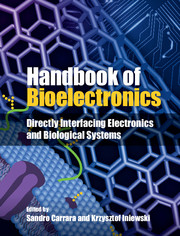Book contents
- Frontmatter
- Contents
- List of Contributors
- 1 What is bioelectronics?
- Part I Electronic components
- Part II Biosensors
- Part III Fuel cells
- Part IV Biomimetic systems
- Part V Bionics
- Part VI Brain interfaces
- 27 Introduction to brain–machine interfaces
- 28 ECG technology for the brain–machine interface
- 29 Reducing the implant footprint: low-area neural recording
- 30 Electrical stimulation
- 31 Biological channel modeling and implantable UWB antenna design for neural recording systems
- 32 Intracranial epilepsy monitoring using wireless neural recording systems
- 33 Low-power building blocks for neural recording systems
- 34 CMOS circuits for intracellular brain–machine interfaces
- Part VII Lab-on-a-chip
- Part VIII Future perspectives
- Index
- References
34 - CMOS circuits for intracellular brain–machine interfaces
from Part VI - Brain interfaces
Published online by Cambridge University Press: 05 September 2015
- Frontmatter
- Contents
- List of Contributors
- 1 What is bioelectronics?
- Part I Electronic components
- Part II Biosensors
- Part III Fuel cells
- Part IV Biomimetic systems
- Part V Bionics
- Part VI Brain interfaces
- 27 Introduction to brain–machine interfaces
- 28 ECG technology for the brain–machine interface
- 29 Reducing the implant footprint: low-area neural recording
- 30 Electrical stimulation
- 31 Biological channel modeling and implantable UWB antenna design for neural recording systems
- 32 Intracranial epilepsy monitoring using wireless neural recording systems
- 33 Low-power building blocks for neural recording systems
- 34 CMOS circuits for intracellular brain–machine interfaces
- Part VII Lab-on-a-chip
- Part VIII Future perspectives
- Index
- References
Summary
The conventional brain–machine interface (BMI) concept is based on an electrical circuit that includes electrodes for sensing and/or stimulation. In most cases, electrodes are in contact with biological tissue, while the electrical circuit can be positioned on the backside of electrodes or connected through a wireless link [1–3]. In both cases, a tremendous amount of work is done to design a high-sensitivity circuit to detect a few millivolts related to electrical signal propagation in the brain [4, 5].
With recent advances in microfabrication and processing, more advanced systems can be considered to build a BMI [6–8]. Following these major advances, the highly integrated lab-on-a-chip (LoC) emerged, which led to the design of compact LoC in the size range of a few millimeters [9, 10]. LoC has become attractive as an advanced brain–machine interface and a promising approach for future new brain discoveries.
Conventional brain–machine interfaces: deep brain electrode stimulation
There are two major operations that are handled by BMI, which are stimulation and sensing. Conventional BMIs are deep brain electrodes (DBE) or patch electrodes [11, 12] used to detect the electrical activity of the brain. In the stimulation mode, DBE applies voltages or currents to tissue to generate action potentials (AP). In the sensingmode electrodes are used to detect the propagation of AP and brain electrical activity.
- Type
- Chapter
- Information
- Handbook of BioelectronicsDirectly Interfacing Electronics and Biological Systems, pp. 414 - 422Publisher: Cambridge University PressPrint publication year: 2015



